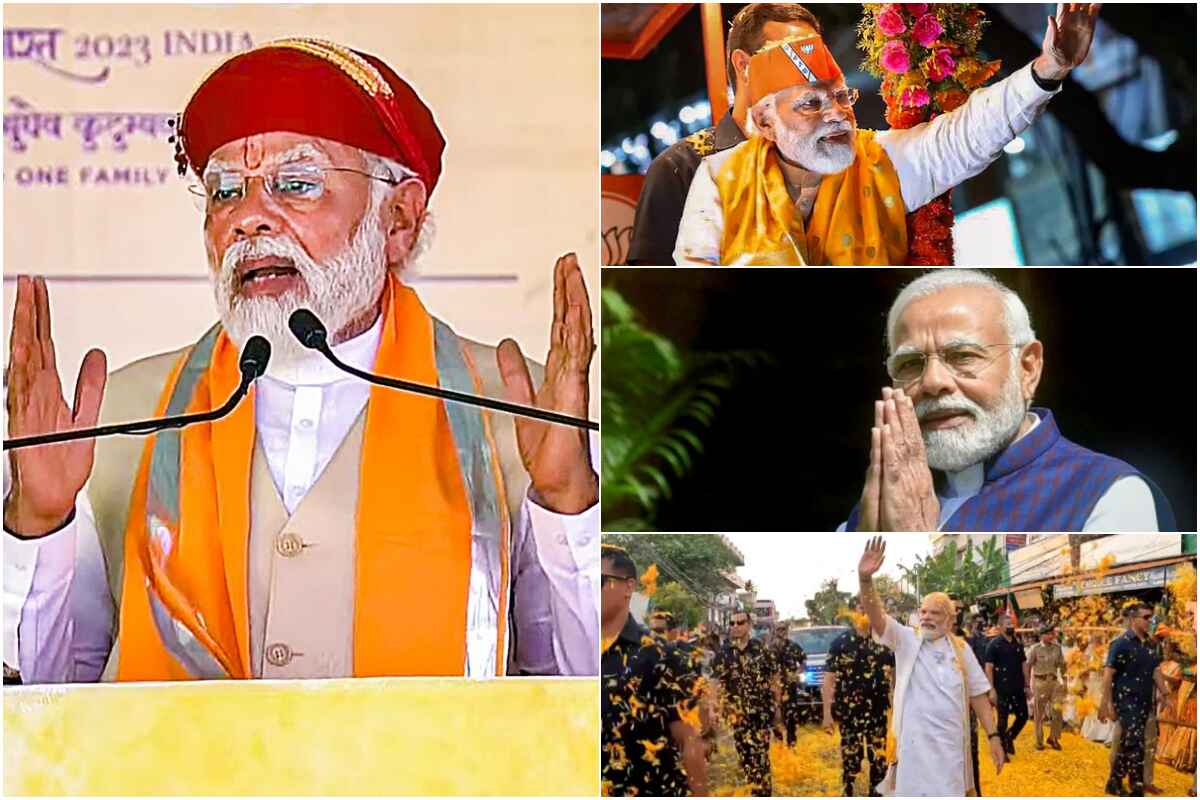
The Modi government has entered its 10th year on a positive note, defying the global trend of recession. India has registered a GDP growth rate of 7.2 percent in the fiscal year 2022-23. Additionally, GST collection reached a record level of rupees 1.57 lakh crore in May. Credit rating agency Moody’s, along with the United Nations World Economic Monitoring Unit, has predicted a bull run for India’s economy in the
coming five years.
These facts are just the latest examples of the Modi government’s success in keeping the Indian economy on an ascending path, despite the aftereffects of demonetization, the Covid-19 pandemic, and Russia’s invasion of Ukraine.
A strong performance on the economic front has been a hallmark of PM Modi’s tenure. India has jumped from the 10th spot among the world’s largest economies in 2014 to the 5th position under the Prime Minister’s watch, leaving behind the UK, France, Italy, Canada, and Brazil.
We see the same pattern in the Modi government’s performance on various fronts, such as social welfare, politics, and international relations. As the Prime Minister stated on the 9th anniversary of his government, every decision in Modi’s era is aimed at uplifting the lives of the Indian masses. He claims to have taken a vow to make every possible effort to build a developed India.
India has managed to widen its interests to match the aspirations of its people under PM Modi’s leadership. He has prioritized the welfare of 80 crore families living below the poverty line above everything else. Many of the PM’s actions have helped these families become self-reliant. Food subsidy has tripled to Rs 18.10 lakh crore under this government, from Rs 5.16 lakh crore during 2004-2014.
Social welfare is among the primary reasons for the Modi phenomenon. Many of his schemes have reached the last mile. Initiatives like Ujjwala Yojana, Ayushman Bharat, the Housing Scheme, the National Cleanliness Mission, and other measures in the farming sector have raised the living standards of billions of Indians. Schemes like Jan Dhan Yojana have empowered an additional 50 crore people with bank accounts. Many social benefits, such as direct subsidies, now reach them directly. Aadhar and the penetration of mobile networks have taken banking to the doorstep of India’s poor. Crores of people have accessed easy loans under the Mudra Scheme. All of this has led to a majority that still aspires for the future. No index can measure these aspirations.
The Prime Minister’s commitment to cleanliness is momentous. He has emphasized ensuring clean water and atmosphere for all since his first day in office. This dedication to the cause has freed more than 3 lakh villages from the scourge of open defecation. Over 4 lakh villages have adopted the method of wet and dry garbage segregation. Similarly, many steps under the Jal Shakti Mission have provided safe water to millions of households, saving them from costly medical bills. The Modi government has shown a serious commitment to providing housing for every Indian. More than 74 lakh houses were built from 2015 to 2023 under the PM Housing Scheme. Comparing this to only 8.04 lakh houses built for Low-Income Groups (LIG) and Economically Weaker sections (EWS) from 2004 to 2014 makes the difference clear.
The past nine years have also been Amritkal, a golden era for nation-building. India’s basic infrastructure is rapidly transforming. National Highways and Expressways are expanding at a breakneck pace, and indigenously built Vande Bharat trains are providing a first-world travel experience to the masses. The railways are not only growing in quality but also in reach. The UDAN scheme has brought India’s far-off corners closer to its heart. PM Modi has demonstrated far-sightedness in building many new IITs, IIMs, and institutions of the same caliber. As many as 9000 new colleges have been built since 2014, while the number of universities has risen from 723 to 1113 during the same period.
On the other hand, there are many accomplishments that are well-publicized both domestically and abroad. A few examples include the repeal of Article 370, the speedy Ram Mandir construction, the Kashi Vishwanath corridor, the elimination of triple talaq, indigenization in the defense industry, a more articulate foreign policy, and India’s role as a global ambassador during the COVID era. The respect that Prime Minister Modi is accorded by other nations demonstrates his rising status on the international stage. The Order of Abdulaziz Al Saud, Saudi Arabia’s highest civilian honor, started a trend in 2016 that has subsequently spread to nations like Afghanistan, Palestine, the United Arab Emirates, Russia, and the Maldives.
The world witnessed the most powerful man in the world, Joe Biden, wanting Prime Minister Modi’s autograph, and Ukrainian President Volodymyr Zelensky knocking on his door seeking intervention to end his country’s misery. Australian Prime Minister Anthony Albanese called him the “boss,” while his Papua New Guinea counterpart touched the Indian Prime Minister’s feet as a mark of respect. And all of this happened in less than a week!
However, the past nine years have also been about challenges and some bitter realities. Unemployment remains a thorn in India’s path to glory. According to data from the Centre for Monitoring Indian Economy (CMIE), the unemployment rate has risen to 8.72 percent compared to 5.4 percent in 2014. The National Sample Survey Office (NSSO) figures for the January-March period this year put the number at 6.8 percent among urban youth over 15 years of age.
Top of Form
The promise of the abrogation of Article 370 has been fulfilled, and the construction of the Ram Temple in Ayodhya is already underway. However, the implementation of a nationwide Uniform Civil Code (UCC), which has been a part of the BJP’s manifesto since 1989, is still pending. The party believes that it is necessary to ensure gender equality across all sections of society.
The party has undertaken experiments in this regard in certain states. The BJP governments in Uttarakhand, Gujarat, and Madhya Pradesh have established expert committees to address this issue. We hear discussions on this topic during almost every state election. It was a part of the BJP’s electoral campaign in Uttar Pradesh, Uttarakhand, Punjab, Goa, Manipur, Himachal Pradesh, Gujarat, and most recently, Karnataka. It is likely to follow a similar approach in the remaining five states going to polls this year. The BJP appears to be testing the waters on a smaller scale before formulating a national plan for the Common Civil Code. It will proceed with its next steps only after achieving a broad consensus. However, obtaining such consensus may not be easy, given the upcoming major battle for the Lok Sabha in 2024.


















